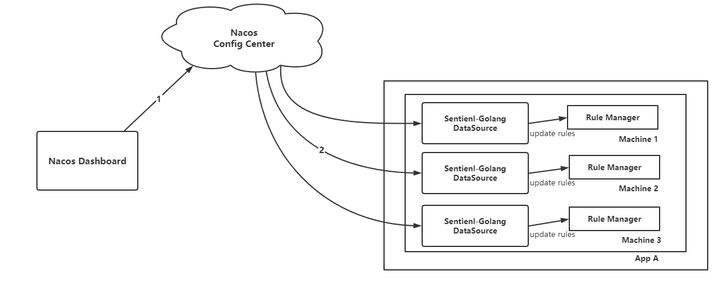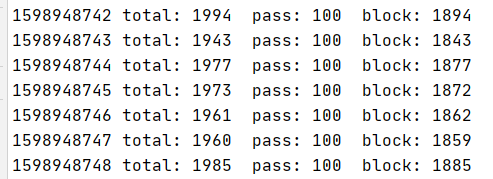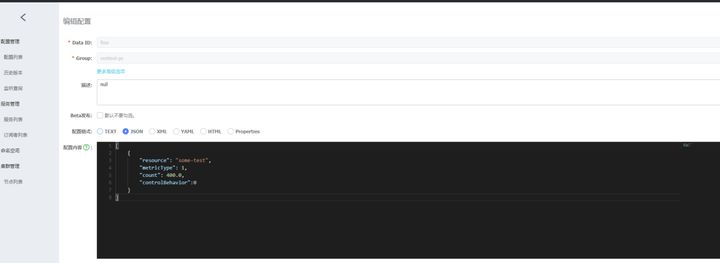您好,登錄后才能下訂單哦!
您好,登錄后才能下訂單哦!
本篇文章給大家分享的是有關Sentinel-Go中怎么利用Nacos 實現外部動態數據源,小編覺得挺實用的,因此分享給大家學習,希望大家閱讀完這篇文章后可以有所收獲,話不多說,跟著小編一起來看看吧。
隨著微服務的流行,服務和服務之間的穩定性變得越來越重要。Sentinel 以流量為切入點,從流量控制、熔斷降級、系統負載保護等多個維度保護服務的穩定性。
Sentinel 具有以下特征:
豐富的應用場景:Sentinel 承接了阿里巴巴近 10 年的雙十一大促流量的核心場景,例如秒殺(即突發流量控制在系統容量可以承受的范圍)、消息削峰填谷、集群流量控制、實時熔斷下游不可用應用等。
完備的實時監控:Sentinel 同時提供實時的監控功能。您可以在控制臺中看到接入應用的單臺機器秒級數據,甚至 500 臺以下規模的集群的匯總運行情況。
廣泛的開源生態:Sentinel 提供開箱即用的與其它開源框架/庫的整合模塊,例如與 Spring Cloud、Dubbo、gRPC 的整合。您只需要引入相應的依賴并進行簡單的配置即可快速地接入 Sentinel。
完善的 SPI 擴展點:Sentinel 提供簡單易用、完善的 SPI 擴展接口。您可以通過實現擴展接口來快速地定制邏輯。例如定制規則管理、適配動態數據源等。
2012年,Sentinel 誕生,主要功能為入口流量控制。
2013-2017年,Sentinel 在阿里巴巴集團內部迅速發展,成為基礎技術模塊,覆蓋了所有的核心場景。Sentinel 也因此積累了大量的流量歸整場景以及生產實踐。
2018年,Sentinel 開源,并持續演進。
2019年,Sentinel 在多語言擴展的方向上逐步探索,陸續推出 C++ 原生版本、Envoy 集群流量控制支持。
Nacos是一個更易于構建云原生應用的動態服務發現、配置管理和服務管理的平臺,Nacos脫胎于阿里巴巴內部的ConfigServer和Diamond,是它們的開源實現。經歷過雙十一流量峰值和阿里巴巴經濟體超大規模容量的考驗,沉淀了阿里巴巴軟負載團隊在這個領域十年的經驗,在穩定性和功能性上都有很好的保障。

(Sentinel-Go集成Nacos動態數據源架構)
目前 Sentinel 內部的限流、熔斷等策略都是基于規則來實現的,提供動態數據源擴展的目的,就是希望將規則數據的加載以及更新操作通過一些配置中心中間件(比如 nacos,etcd,conful,等等)來實現動態更新。
未集成nacos時 規則定義在代碼內部,沒有使用外部數據源。
go get http://github.com/alibaba/sentinel-golang
使用 Sentinel 主要分為以下幾步:
對 Sentinel 進行相關配置并進行初始化
埋點(定義資源)
配置規則
package main
import (
"fmt"
"log"
"math/rand"
"time"
sentinel "github.com/alibaba/sentinel-golang/api"
"github.com/alibaba/sentinel-golang/core/base"
"github.com/alibaba/sentinel-golang/core/flow"
"github.com/alibaba/sentinel-golang/util"
)
func main() {
// We should initialize Sentinel first.
err := sentinel.InitDefault()
if err != nil {
log.Fatalf("Unexpected error: %+v", err)
}
_, err = flow.LoadRules([]*flow.FlowRule{
{
Resource: "some-test",
MetricType: flow.QPS,
Count: 10,
ControlBehavior: flow.Reject,
},
})
if err != nil {
log.Fatalf("Unexpected error: %+v", err)
return
}
ch := make(chan struct{})
for i := 0; i < 10; i++ {
go func() {
for {
e, b := sentinel.Entry("some-test", sentinel.WithTrafficType(base.Inbound))
if b != nil {
// Blocked. We could get the block reason from the BlockError.
time.Sleep(time.Duration(rand.Uint64()%10) * time.Millisecond)
} else {
// Passed, wrap the logic here.
fmt.Println(util.CurrentTimeMillis(), "passed")
time.Sleep(time.Duration(rand.Uint64()%10) * time.Millisecond)
// Be sure the entry is exited finally.
e.Exit()
}
}
}()
}
<-ch
}Sentinel-Go集成Nacos實現外部動態數據源功能.
您可以在Nacos的release notes及博客中找到每個版本支持的功能的介紹,當前推薦的穩定版本為1.3.1。
Nacos 依賴 Java 環境來運行。如果您是從代碼開始構建并運行Nacos,還需要為此配置 Maven環境,請確保是在以下版本環境中安裝使用:
64 bit OS,支持 Linux/Unix/Mac/Windows,推薦選用 Linux/Unix/Mac。
64 bit JDK 1.8+;下載 & 配置。
Maven 3.2.x+;下載 & 配置。
你可以通過源碼和發行包兩種方式來獲取 Nacos。
從 Github 上下載源碼方式
git clone https://github.com/alibaba/nacos.git cd nacos/ mvn -Prelease-nacos -Dmaven.test.skip=true clean install -U ls -al distribution/target/ // change the $version to your actual path cd distribution/target/nacos-server-$version/nacos/bin
下載編譯后壓縮包方式
您可以從 最新穩定版本 下載 nacos-server-$version.zip 包。
unzip nacos-server-$version.zip 或者 tar -xvf nacos-server-$version.tar.gz cd nacos/bin
Linux/Unix/Mac
啟動命令(standalone代表著單機模式運行,非集群模式):
sh startup.sh -m standalone
如果您使用的是ubuntu系統,或者運行腳本報錯提示[[符號找不到,可嘗試如下運行:
bash startup.sh -m standalone
Windows
啟動命令:
cmd startup.cmd
或者雙擊startup.cmd運行文件。
部署成功訪問 http://127.0.0.1:8848/nacos
用戶名/密碼:nacos/nacos
登錄到nacos web
在配置管理中,新建配置
輸入dataId,group(dataId,group 創建時可以自定義,本文創建的dataId=flow,group=sentinel-go)
將數據源樣例粘貼到配置內容中。
此樣例是流量控制的Demo配置。當流量并發數大于100直接拒絕。
[
{
"resource": "some-test",
"metricType": 1,
"count": 100.0,
"controlBehavior":0
}
]創建完成后,在nacos配置列表中可以看到對應的限流配置。

版本
sentinel-golang 版本使用0.6.0,nacos-sdk-go 使用1.0.0
go.mod
module sentinel-go-nacos-example go 1.13 require ( github.com/alibaba/sentinel-golang v0.6.0 github.com/nacos-group/nacos-sdk-go v1.0.0 )
main.go
package main
import (
"fmt"
"math/rand"
"sync/atomic"
"time"
sentinel "github.com/alibaba/sentinel-golang/api"
"github.com/alibaba/sentinel-golang/core/base"
"github.com/alibaba/sentinel-golang/ext/datasource/nacos"
"github.com/alibaba/sentinel-golang/util"
"github.com/nacos-group/nacos-sdk-go/clients"
"github.com/alibaba/sentinel-golang/ext/datasource"
"github.com/nacos-group/nacos-sdk-go/common/constant"
)
type Counter struct {
pass *int64
block *int64
total *int64
}
func main() {
//流量計數器,為了流控打印日志更直觀,和集成nacos數據源無關。
counter := Counter{pass: new(int64), block: new(int64), total: new(int64)}
//nacos server地址
sc := []constant.ServerConfig{
{
ContextPath: "/nacos",
Port: 8848,
IpAddr: "127.0.0.1",
},
}
//nacos client 相關參數配置,具體配置可參考https://github.com/nacos-group/nacos-sdk-go
cc := constant.ClientConfig{
TimeoutMs: 5000,
}
//生成nacos config client(配置中心客戶端)
client, err := clients.CreateConfigClient(map[string]interface{}{
"serverConfigs": sc,
"clientConfig": cc,
})
if err != nil {
fmt.Printf("Fail to create client, err: %+v", err)
return
}
//注冊流控規則Handler
h := datasource.NewFlowRulesHandler(datasource.FlowRuleJsonArrayParser)
//創建NacosDataSource數據源
//sentinel-go 對應在nacos中創建配置文件的group
//flow 對應在nacos中創建配置文件的dataId
nds, err := nacos.NewNacosDataSource(client, "sentinel-go", "flow", h)
if err != nil {
fmt.Printf("Fail to create nacos data source client, err: %+v", err)
return
}
//nacos數據源初始化
err = nds.Initialize()
if err != nil {
fmt.Printf("Fail to initialize nacos data source client, err: %+v", err)
return
}
//啟動統計
go timerTask(&counter)
//模擬流量
ch := make(chan struct{})
for i := 0; i < 10; i++ {
go func() {
for {
atomic.AddInt64(counter.total, 1)
//some-test 對應在nacos 流控配置文件中的resource
e, b := sentinel.Entry("some-test", sentinel.WithTrafficType(base.Inbound))
if b != nil {
atomic.AddInt64(counter.block, 1)
// Blocked. We could get the block reason from the BlockError.
time.Sleep(time.Duration(rand.Uint64()%10) * time.Millisecond)
} else {
atomic.AddInt64(counter.pass, 1)
time.Sleep(time.Duration(rand.Uint64()%10) * time.Millisecond)
// Be sure the entry is exited finally.
e.Exit()
}
}
}()
}
<-ch
}
//statistic print
func timerTask(counter *Counter) {
fmt.Println("begin to statistic!!!")
var (
oldTotal, oldPass, oldBlock int64
)
for {
time.Sleep(1 * time.Second)
globalTotal := atomic.LoadInt64(counter.total)
oneSecondTotal := globalTotal - oldTotal
oldTotal = globalTotal
globalPass := atomic.LoadInt64(counter.pass)
oneSecondPass := globalPass - oldPass
oldPass = globalPass
globalBlock := atomic.LoadInt64(counter.block)
oneSecondBlock := globalBlock - oldBlock
oldBlock = globalBlock
fmt.Println(util.CurrentTimeMillis()/1000, "total:", oneSecondTotal, " pass:", oneSecondPass, " block:", oneSecondBlock)
}
}
在項目啟動過程中,在nacos中修改流控配置參數。將count 從100->400

可以看到打印了重新loadRule的日志,流量控制動態的由100->400

在sentinel-go中使用nacos作為外部動態數據源,只需要將原來聲明Rule以及加載Rule的部分 變成從nacos數據源讀取。
在本文中只介紹了流量控制的集成,熔斷,warmup,熱點參數的集成也是相同的,只要按需修改配置的內容即可
關鍵代碼:
h := datasource.NewFlowRulesHandler(datasource.FlowRulesJsonConverter)
nds, err := nacos.NewNacosDataSource(client, "sentinel-go", "flow", h)
if err != nil {
fmt.Printf("Fail to create nacos data source client, err: %+v", err)
return
}
err = nds.Initialize()
if err != nil {
fmt.Printf("Fail to initialize nacos data source client, err: %+v", err)
return
}以上就是Sentinel-Go中怎么利用Nacos 實現外部動態數據源,小編相信有部分知識點可能是我們日常工作會見到或用到的。希望你能通過這篇文章學到更多知識。更多詳情敬請關注億速云行業資訊頻道。
免責聲明:本站發布的內容(圖片、視頻和文字)以原創、轉載和分享為主,文章觀點不代表本網站立場,如果涉及侵權請聯系站長郵箱:is@yisu.com進行舉報,并提供相關證據,一經查實,將立刻刪除涉嫌侵權內容。